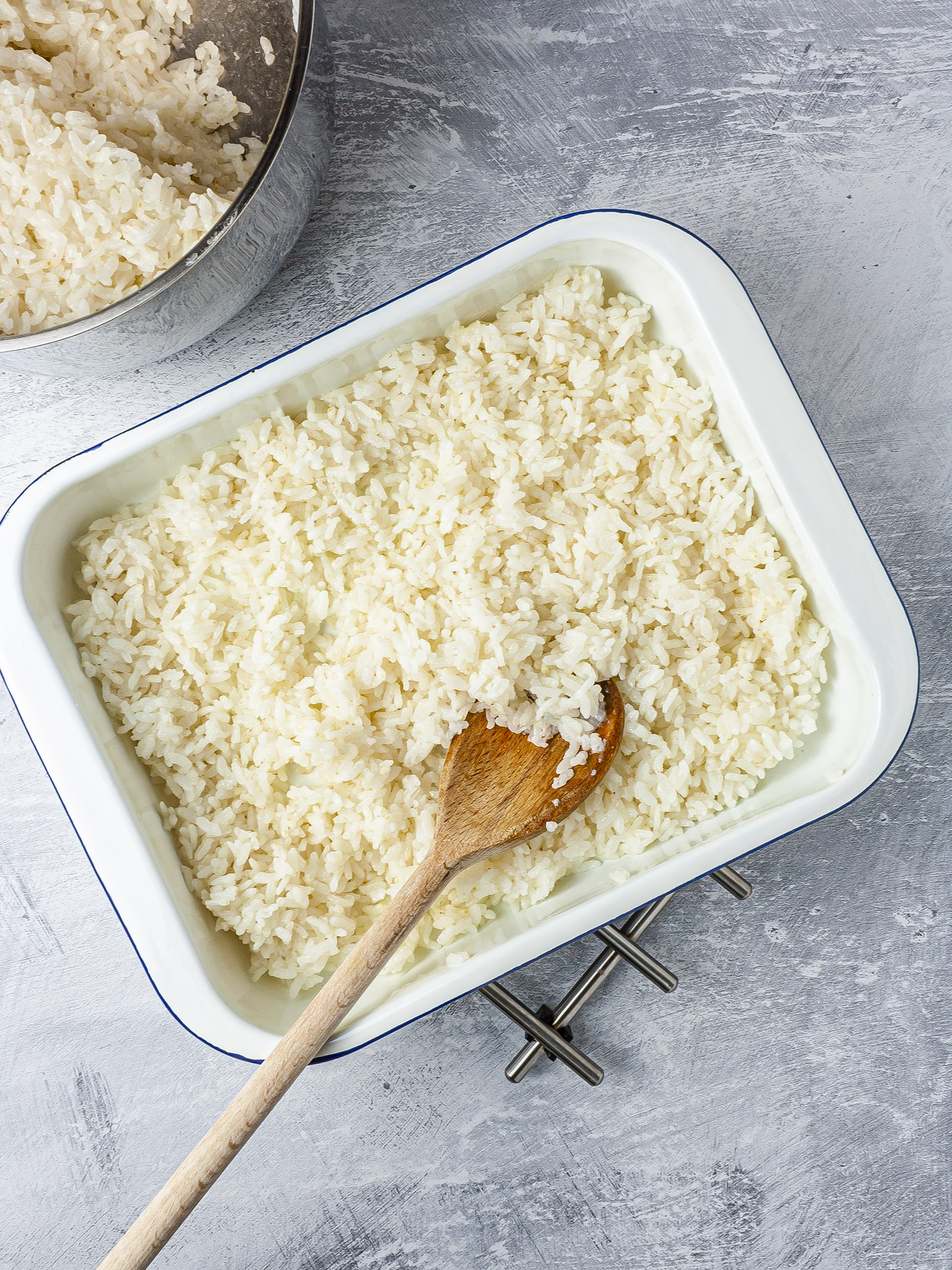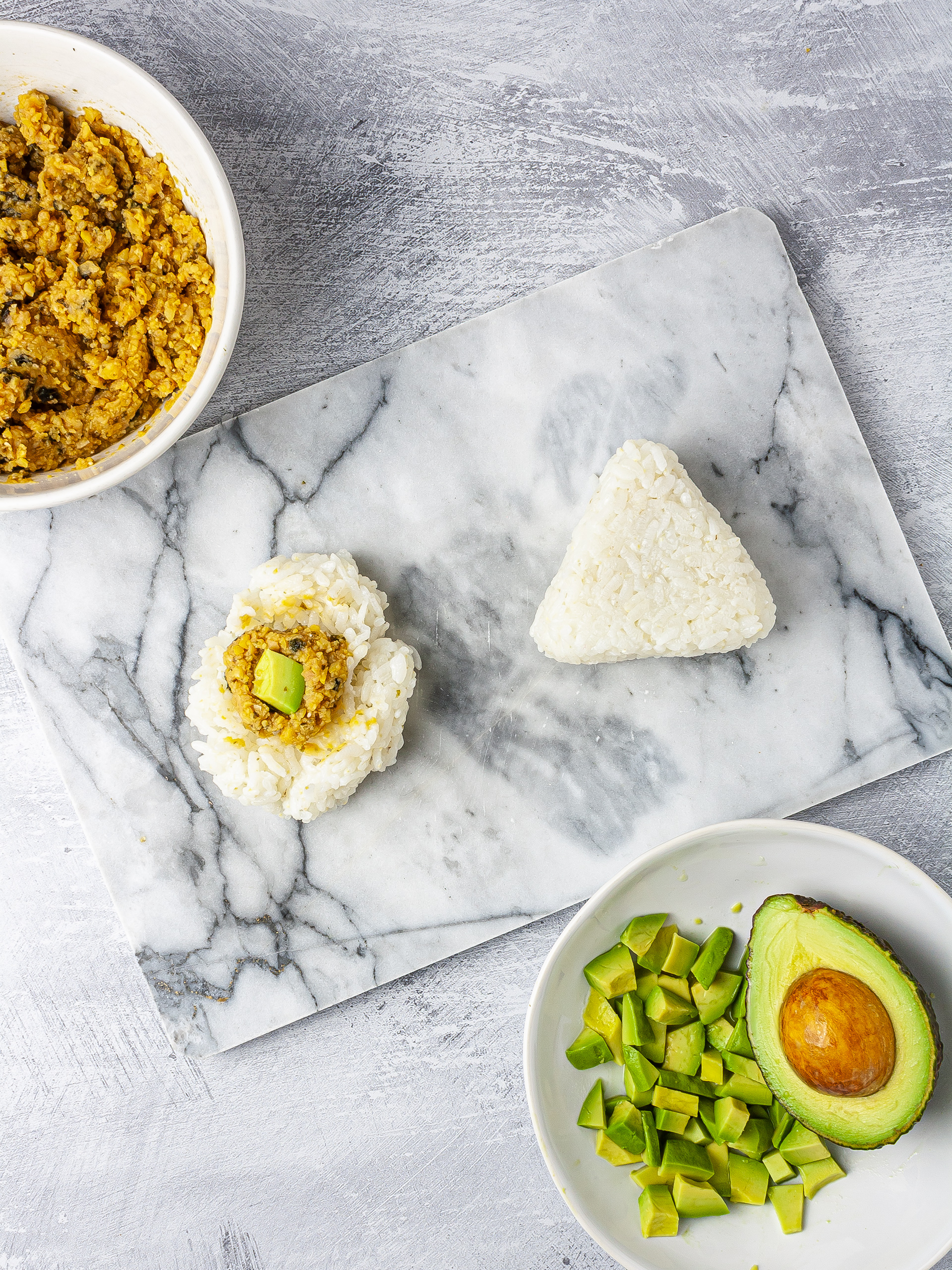Today we will show you how to make vegan onigiri with a filling of "tuna" and avocado. To make vegan tuna, we used a base of mashed chickpeas, mixed with nori flakes and sprinkled with soy sauce and rice vinegar. Close your eyes and let your taste buds take the lead on this one: this mix is mighty fishy (pun intended)!
Onigiri is a timeless Japanese starter recipe consisting of sticky rice ball shaped like a triangle filled with tasty ingredients and wrapped in an algae "nori" sheet. The nori sheets bring in a piquant sea flavour while keeping your hands clean: so practical!
The first onigiri traces back to 2000 years ago. Think of it as the healthy grandaddy of arancini, where instead of nori you have fried breadcrumbs. Just like arancini or sandwiches, onigiri let us be imaginative when choosing the perfect filling.
Traditional onigiri use various fish or crustaceans as filling, which pair well with the nori. Salmon, tuna and prawns are well-known ingredients used in these sticky rice snack.
There are also excellent vegetarian options, like those made with tofu, eggs, avocado or edamame beans. For our recipe, we have used 100% vegan ingredients so that most of you, regardless of your diet or food allergies, will be able to enjoy these rice balls.
Chickpeas pale colour resembles that of canned tuna when mashed. Moreover, chickpeas are an excellent source of protein, which is abundant in real tuna. The nori adds the fish flavour, while the soy sauce and rice vinegar bring in some Japanese flair.
Our steps below are super easy to follow, so let's have some fun preparing these healthy vegan onigiri together!
How long can you keep onigiri?
You should consume onigiri made with raw meat or fish as soon as prepared, or after no more than 6 hours if stored in the fridge. Cooked meat and fish would last for up to three days instead once refrigerated.
Our onigiri are made solely with plant-based ingredients, which keep longer in the fridge compared to animal products. As such, you can store these vegan tuna onigiri in the refrigerator for up to 5 days before eating.
If you plan on batch cooking these Japanese rice balls, you should keep the nori and rice separated. To preserve the nori crispiness, keep it in its sachet and only wrap around the rice before eating.
What rice to use for onigiri?
To make the perfect onigiri rice balls, we need sticky rice. The best rice for this occasion is sushi rice.
Sushi rice, also known as Japonica rice, is a type of short-grain cultivated extensively in Japan, China and Korea. This rice is ideal for dishes consumed with chopsticks, like sushi and chirashi bowls, as the higher content of amylopectin makes it stickier than the long-grain siblings [1]. This stickiness is essential to hold the onigiri together.
If your local store is out of Japonica rice, medium-grain California rice is an excellent substitute to make onigiri.
A viable sushi rice alternative for our European friends is risotto (Arborio rice). The short-grained Italian rice makes decent onigiri as it's quite sticky. If you have an urgent need for onigiri (who doesn't) but are out of sushi rice, Arborio rice will not disappoint.
Do you consider yourself a bit of a rebel? Then how about using some forbidden rice to make black onigiri? Black sushi rice - called forbidden since no one but the Chinese emperor was important enough to eat it - is not just beautiful, but also rich in potent antioxidants.
If you like the idea of eating black sushi rice balls but can't find the rice, why not make your own? Mix a few drops of squid ink with plain sushi rice for a luscious black tint and extra sea flavour.
Are onigiri a healthy snack?
If we ignore the filling for a moment, an onigiri is just a ball of steamed rice and a sheet of dry seaweed.
Steamed rice is an excellent source of energy capable of making us feel full without overeating. Although brown rice is the clear winner in terms of nutrients, sushi rice is still a good source of vitamin B and essential minerals [2].
Nori is a crispy little marvel, rich in antioxidants, vitamins and minerals. But the most impressive trait of this dry seaweed is the high amount of iodine, essential to a healthy thyroid. Research shows that iodine-rich foods are among the key elements that make the Japanese diet so healthy [3].
So the onigiri is healthy, but whether it stays that way or not will depend on the ingredients we use inside.
We made our vegan "tuna" and avocado Japanese rice balls using nourishing ingredients like avocado and chickpeas.
Avocado is rich in unsaturated fats that are good for your heart, similar to those of extra virgin olive oil. Moreover, its creamy flesh packs loads of fibres for that promote a healthy digestive system. On top of this, this fruit gives us almost all the vitamins out there. We could think of nothing better for our healthy onigiri recipe.
Chickpeas don't play around either. They are an excellent source of plant-based proteins, which we would lose when swapping out tuna. They also have few calories compared to the nutrients they provide [4], which makes them ideal additions to weight-loss meal plans.
Overall, we are happy about the health profile of our vegan onigiri, especially since they are so cute and delicious!
Are onigiri gluten-free?
Our vegan onigiri are gluten-free, like most others. But if you suffer from gluten allergies, you should pay extra care as there are some subtle exceptions. Let's take a look at some of them.
Soy sauce is a common ingredient in onigiri fillings. But did you know the traditional soy sauce is not gluten-free? Not many do. Pay particular attention to this ingredient next time you order onigiri, especially at street food stalls. You should ask the person serving you if the soy sauce they used is gluten-free. If they give you a vague answer, and you are allergic to gluten, you better walk away.
You should also be wary of Mayonnaise. Although the majority of mayo brands are gluten-free, there are some exceptions. If your onigiri filling comes with this sauce, be safe and ask whether it's suitable for people with gluten intolerance.
Finally, take a good look at the ingredients used in vegan onigiri. Many vegan substitutes, especially mass-produced ones, use a variety of ingredients to emulate the original food successfully. Among these you may have flours and starches, often used to bind the other ingredients together. So next time you are buying "vegan chorizo" onigiri, or whatever, give that label a good read.
Ingredients
| For the Onigiri Rice Balls | |
| Sushi Rice | 270 g |
| Water | 450 mL |
| Salt | to taste |
| For the Vegan Filling | |
| Cooked Chickpeas | 60 g |
| Gluten-Free Soy Sauce | 1/2 tbsp |
| Rice Vinegar | 1/2 tbsp |
| Garlic Powder | 1/4 tsp |
| Avocado | 1/2 |
| Others | |
| Sesame Seeds | 15 g |
| Nori Sheets | 2 |
Step 1
Let's start by preparing the sushi rice for these vegan onigiri.
To remove excess starch, rinse the short-grain rice two or three times until the drained water is clear. Then allow the rice to drain for 15 minutes on a colander.
Transfer the rice into a deep pot, pour the water, add salt, and give all a good stir (1).
Bring to a boil and then cook covered for 10-15 minutes. After this time, the water should have evaporated, but keep cooking the rice for a few more minutes if you still have water in your pot. Don't stir the rice during cooking time.
Next, remove the pan from the heat and allow the rice to steam covered for further 15 minutes.
Once the rice is steamed, transfer it onto a large plate or tray and, using a wooden spoon, fluff the rice to speed up the cooling time (2). Make sure the sushi rice is cool enough to work with it, but you don't want to cool it completely, or it won't hold together as well.


Step 2
In the meantime, prepare the vegan "tuna" filling.
Blitz the cooked chickpeas into a paste and then mix them with soy sauce, rice vinegar, garlic powder, and season with salt.
Stir in 1 nori sheets torn into flakes for a delicious 'fishy' flavour.
The filling should be creamy, so add a splash of water if needed.

Step 3
Before you proceed with shaping the rice balls, make sure to wet your hands with cold water. By doing so, the rice won't stick to your palms, and it will be easier to mold into onigiri triangles.
Get a handful of sticky rice in your hand and make a well by poking it with your finger. Add the prepared 'vegan' tuna filling and avocado chopped into small chunks.
Wrap and press the rice around the filling until a rice ball comes together. Then, shape it into a triangle.

Step 4
Next, cut the remaining 1 nori sheet into rectangles and use them to wrap the base of the onigiri. This way, you won't touch the sticky rice when holding one of these rice balls in your hands.
Finally, coat the sides of the onigiri in sesame seeds. You can use white or black sesame seeds, or a combination of them as we did in this recipe.

Tips
For a spicy 'tuna' filling, try adding chilli flakes to the chickpeas stuffing.
